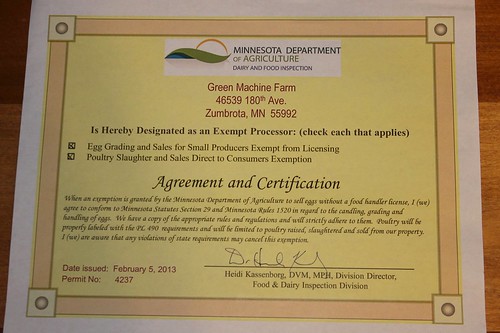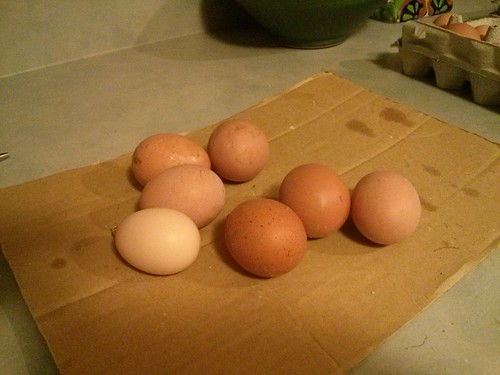It’s still winter here but the days are getting longer, which means that the chickens are kicking the egg-laying into gear in anticipation of spring. We’re currently getting 3-4 dozen per day, up from 1.5 dozen eggs at the beginning of the year. By the time it really starts to warm up we ought to be up to 6 dozen per day.
With that in mind I thought I’d give a quick run-down of our egg packing procedure and all the pertinent laws/regulations that we follow.
So first up, we’re in Minnesota, which means we’re under the jurisdiction of the Minnesota Department of Agriculture (MDA) and having less than 3000 laying hens we do not have to register with the USDA’s Shell Egg Surveillance program. In order to sell our eggs directly to consumers we have to register with the MDA. The one-time registration is free and is on the same form [PDF] as the on-farm poultry processing registration, so you can get both knocked out at once.
When they send you the certificate they also include a hardcopy of the USDA Egg Grading Manual [PDF].
Now that all our paperwork is done, it’s time to do the actual egg packing.
First, as required by the MDA [PDF], we candle our eggs. About the only thing that candling is going to catch is cracked eggs, which you can usually see without candling, and eggs that have been incubated, which we don’t have.
We set aside the cracked and hard-to-clean eggs for our own consumption.
The rest of the eggs get cleaned up and packed in cartons. In Minnesota, there are exactly two permissible ways to clean eggs, according to the MDA.
Option 1 is a multi-thousand-dollar commercial egg washer that’ll do 30+ dozen eggs per hour.
Option 2 is a sheet or two of sandpaper. We chose the 120 grit, as it’s the only affordable option at our scale.
Cleaning the eggs without water doesn’t get them looking as nice, but it does keep the natural film of “bloom” intact, which prevents bacteria from getting into the egg. Egg washers have to be operated within very specific temperature ranges to prevent bacteria from entering the egg. So buying an egg-washer means you’re gonna have to be prepared to keep meticulous records of water temps, chlorine levels and your HAACP plan.
Once they’re all cleaned up, they’re off to the carton.
And here’s where we get to the MDA’s labeling requirements. You can re-use egg cartons in Minnesota, as long as they’re in good shape and as long as you’ve gone through and crossed out all the information from the previous producer. That means crossing out the egg size, grade, pack date, USDA shield logo (if present) and producer name & address. The safe food handling instructions should be left visible.
With all that crossed out, we apply our own label to the carton and write our own pack date. The MDA requires the pack date in a three-digit Julian format, with the “sell by” date (30 days from pack date) in MM/DD format.
Our label provides the other required information: our farm name & address, egg grade and size.

All ready to go in the commercial (NSF-certified) refrigerator at 41°F.





Lots of good info here!
The label in the last picture makes me smile–I know what ‘vegetarian fed’ legally means (no animal byproducts) but in my mind ‘vegetarian’ equates to ‘plant material.’
Then I see ‘free range,’ which suggests to me that they’re going to get some bugs and grubs and other good stuff that strict herbivores wouldn’t eat.
Although, I don’t know…maybe some vegetarians do eat bugs? 🙂